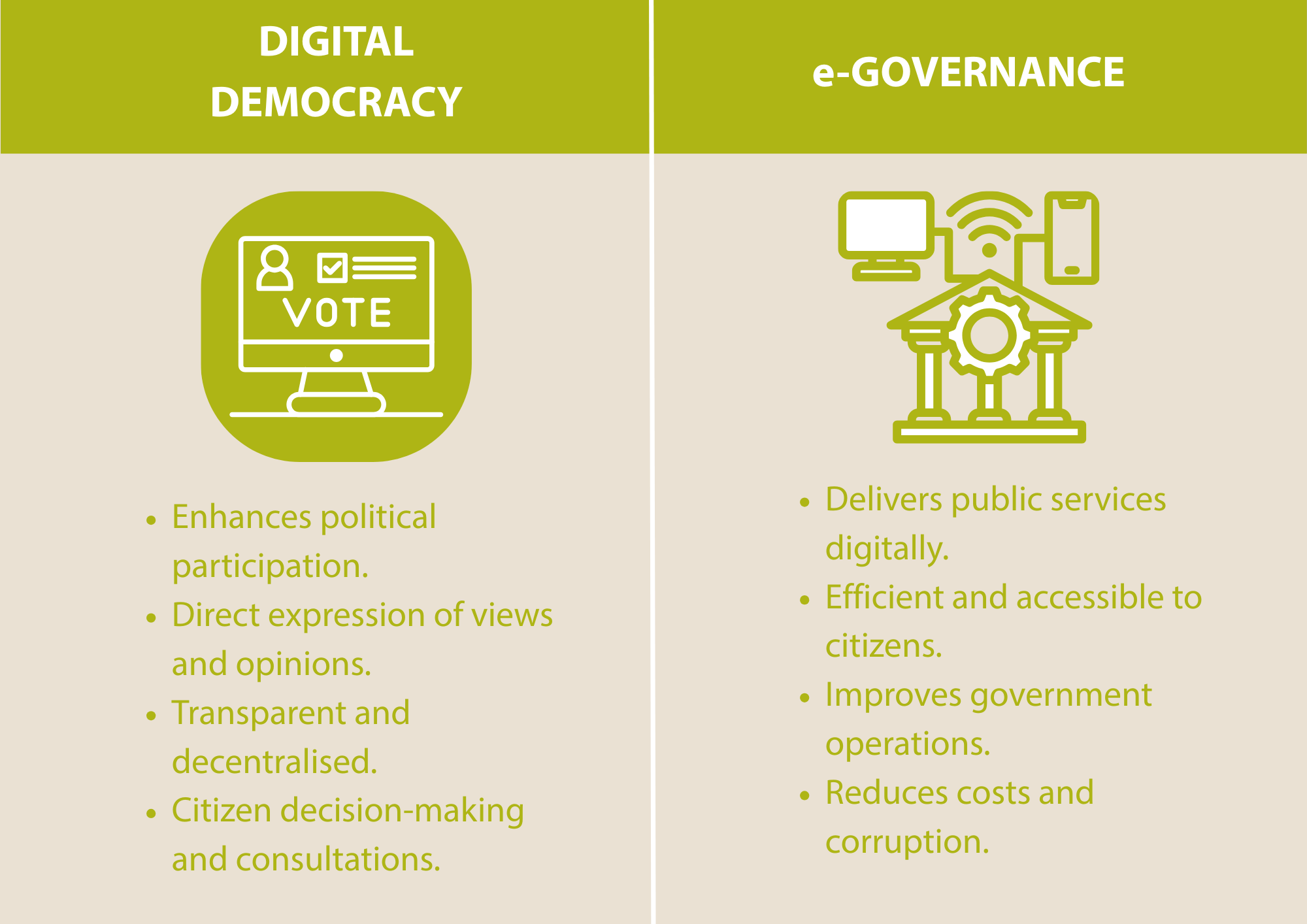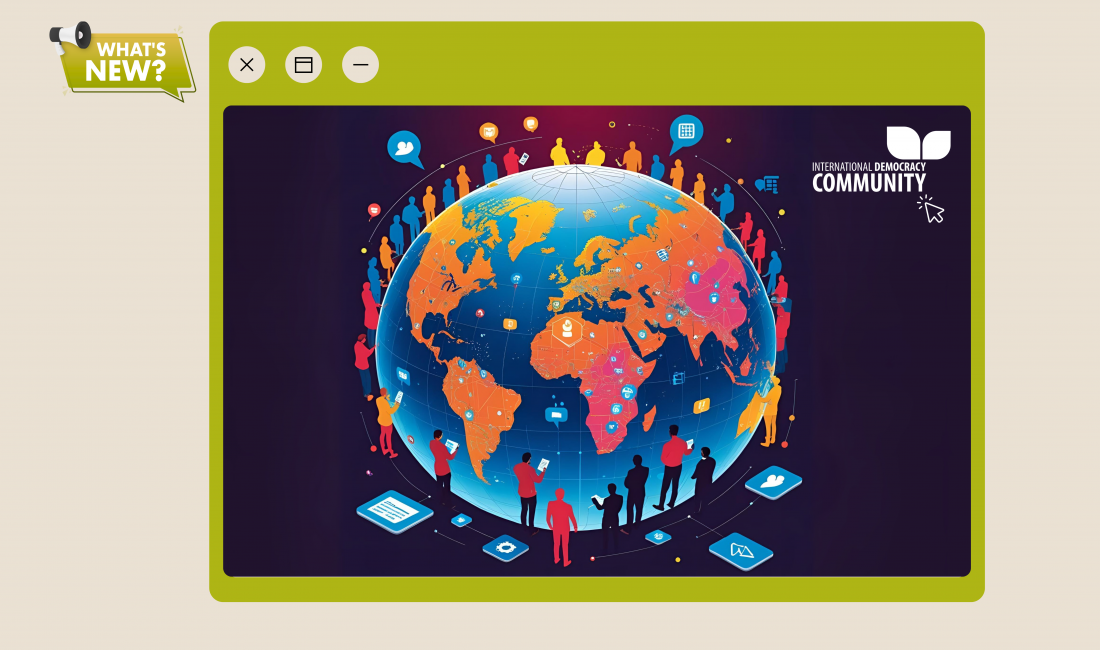On the International Democracy Community (IDC) platform, we're introducing monthly themes inspired by the ideas and interests you shared in our recent survey.
We're kicking things off with the theme Digital Democracy and e-Governance.
To keep things community-driven, we are calling for article submissions!
We invite you to share your expertise, experiences, or reflections on this topic. Please check the box below the article for details on how to send us your submission.
Now, let's dive into this month's theme:
How Tech is Reshaping Participation
In a world where participation in democratic processes is evolving, citizens are turning to digital tools to claim their place in political decision-making.
From online petitions to civic platforms, the theme of the month, Digital Democracy and e-Governance, explores how technology empowers people to participate in shaping their societies. Across the globe, people are finding new and creative ways to get involved in decision-making.
Ever heard of platforms like Consul, vTaiwan or BudgIT?
If not, this Global Spotlight article is here to get you up to speed! While traditional voting remains vital, a growing wave of digital tools is making civic engagement more direct, inclusive and easier than ever.
What is Digital Democracy?
When you hear 'digital democracy', you might picture online voting, apps, or even political debates on social media, and you wouldn't be too far off. Simply put, digital democracy refers to using technology to enhance how people participate in political life. This includes platforms that let citizens vote on issues, suggest ideas, comment on policies, and collaborate with others to solve community problems.
These tools help break down barriers that often make traditional participation hard, especially in terms of time, location and bureaucracy.
While many digital democracy tools operate online, some take a more secure, offline approach. In certain parts of the world, elections in countries like India, Namibia and the United States of America use electronic voting machines to capture votes. In this case, computers are used to collect votes without being connected to the internet. This offline method is known as an 'air-gapped system', and it is essentially designed to enhance security by preventing remote access or interference that may cause election interference.
Digital democracy shifts people from being passive observers of politics to active contributors who shape decisions in real time. It's part of a broader movement to make political engagement more open, accessible, faster and responsive to citizens' voices.
A More Transparent, Connected Democracy
One of the most powerful aspects of digital democracy is how it promotes transparency and accountability. Through social media and civic tech platforms, people share information quickly, document events as they happen, and raise issues that might otherwise go unnoticed.
This essentially means that governments are being watched more closely, not just by journalists or opposition parties, but by everyday people. It also helps activists and community organisers build support across borders in seconds. When used well, these tools can push public institutions to be more open and responsive.
To demonstrate, in Taiwan, citizens, government officials and experts make use of a digital civic engagement platform called vTaiwan. The online civic platform combines online discussion tools with offline consultation to shape public policy. In this regard, citizens, government officials and experts collaboratively deliberate on complex issues. One such example relates to the issue of ride-sharing in the country, where regulatory changes had to be made for the use of Uber and other public transport options in Taiwan. Tools like Pol.is are used in conjunction with the platform to map consensus and disagreement. The process is transparent, inclusive and non-binding, though it can, however, provide recommendations that influence national policies, as seen in the case of Uber in Taiwan.
What About e-Governance?
While digital democracy is all about participation and convenient access, e-governance focuses on service delivery. The term refers to how governments use digital tools, especially Information and Communication Technologies, to provide services to the public more efficiently.
For example, local governments in some countries are using civic tech platforms to both inform and connect with citizens in their communities. In Germany, the capital city, Berlin, promotes transparency through its Open Data Portal, which aims to provide public access to a wide range of datasets from the city administration. Citizens, researchers and developers can directly access information online related to the city's budget, environmental data, population statistics and more.
As such, instead of waiting in long lines at government offices, citizens can also now renew IDs, pay taxes, apply for permits and access public records online. E-governance saves time and money, boosts government performance and encourages more trust in public services. In many countries, e-governance is also being used to fight corruption.

So, What Does Digital Democracy Look Like in Practice?
Let’s take a quick global tour to explore how digital democracy tools are being used across different regions:
Europe: Leading the Civic Tech Movement
e-Estonia (Estonia): Often cited as the world's most advanced digital society, Estonia has integrated e-governance into nearly every aspect of daily life. Citizens use secure digital IDs to vote online, file taxes, access healthcare and manage businesses, all from their devices.
Consul (Spain & global): An open-source participatory platform used for citizen engagement in policymaking, budgeting and debates. Adopted by 130+ institutions in over 35 countries.
Parlement & Citoyens (France): A platform where lawmakers and citizens co-create legislative proposals.
Better Reykjavík (Iceland): Platforms for crowdsourcing citizen ideas and proposals for city development and decision-making.
Delib (UK): A digital consultation and engagement provider offering platforms like Citizen Space to support public consultations for government and institutions.
North America: Focus on Participation and Deliberation
Change.org (USA): A global petition platform enabling users to launch campaigns on social, political and environmental issues.
Mass LBP (Canada): Designs and runs deliberative processes like citizen panels and assemblies to involve the public in policymaking.
South America: Pioneering Participatory Tools
DemocracyOS (Argentina): A platform for open-source deliberation and digital democracy, enabling citizen debate and legislative input.
Participa.br (Brazil): A Brazilian government platform for participatory policymaking and consultation with civil society.
Asia: Blending Tech and Dialogue
vTaiwan (Taiwan): A civic tech process combining online tools and in-person dialogue to build consensus on emerging policy issues.
Pol.is (Taiwan & global): A data-visualisation tool that maps public opinion through open-ended surveys.
Africa: Building Foundations for Transparency
BudgIT (Nigeria): Promotes fiscal transparency by breaking down government budgets and tracking projects through open data.
Mzalendo (Kenya): Enhances parliamentary transparency and civic engagement by tracking MPs' activities, bills and debates.
Oceania: Consensus-Driven Platforms
Loomio (New Zealand): A collaborative decision-making tool used by groups to reach consensus online. Widely used by activists and local governments.
Why It Matters
Digital democracy tools won't replace traditional forms of participation like voting or protesting, but they do offer powerful new ways to stay involved, especially between elections. They can help amplify underrepresented voices, improve transparency and make governments more responsive.
Democracy isn't just analogue, it is digital, dynamic and in your hands.




